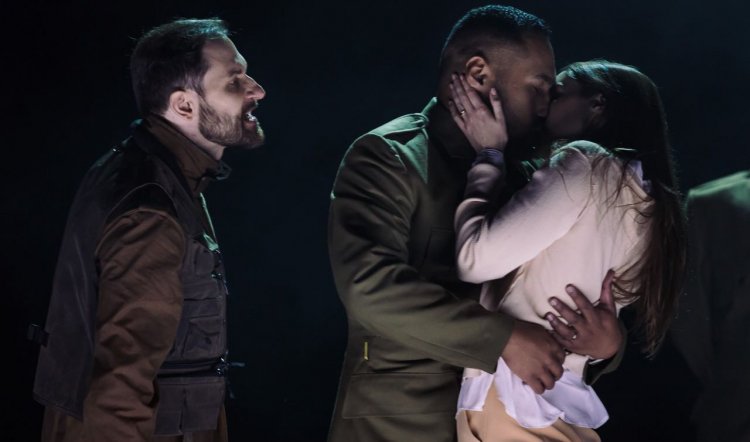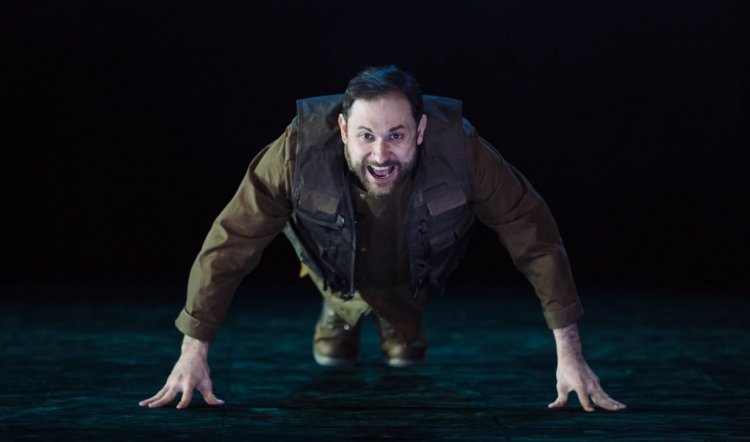
OTHELLO
OTHELLO, Bell Shakespeare Company at the Playhouse, Sydney Opera House, 28 October-4 December 2016. Photography by Daniel Boud: above - Yalin Ozucelik, Ray Chong Nee and Elizabeth Nabben; below - Yalin Ozucelik
Shakespeare’s most (in)famous “green-eyed monster” – jealousy – is the one that hangs over this production, designed by Michael Hankin as an empty cavern of darkest green and intermittently and cruelly illuminated by lighting designer Paul Jackson. The stench of jealousy and it’s equally malign cousin, envy, is thick in the air and creates deep unease from the outset.
Unease also hung in the air in England in 1603, the year before Othello was first performed. Shakespeare’s long-time patron Elizabeth I was finally dead and James VI of Scotland had assumed the throne. He came to London as James I and Shakespeare’s actors troupe – the Chamberlain’s Men – was embraced by the new monarch and renamed “the King’s Men”.
So far so good, but who knew...Sir Walter Raleigh, a favourite of the late queen, was arrested and tried for treason, condemned to death but instead committed to the Tower by the new king. Raleigh was released and allowed to go about his business but was eventually beheaded in 1618 after a failed expedition to the New World. Uncertainty was never far from the surface in 17th century England.
Meanwhile, yet another war between the Irish and the English was temporarily done with victory to the latter. Further away still, but fascinating for Shakespeare, who always favoured politically safer exotic locations, Venice and the Ottoman Turks had been at war for decades. The zeitgeist made it the perfect mix for Othello, a play about jealousy, envy, thwarted ambitions and military adventure.
In all of this world turmoil it could be said that jealousy and envy were prime movers. In his book Jealousy (1988) Peter van Sommers wrote, “Envy concerns what you would like to have but don’t possess, whereas jealousy concerns what you have and do not wish to lose.”
Jealousy has since been examined in a more scholarly style by Peter Toohey, using the same title (2014), and it’s the human emotion that continues to intrigue. It also encapsulates what happens on the island of Cyprus where Othello and his good friend and loyal lieutenant Iago are stationed in service of Venice.
Othello (Ray Chong Nee) is a successful general despite being a “Moor” – the casual and seemingly unconscious racism in every utterance about him makes that clear. In the opening scenes and first half, we see that he is able to rise above the verbal bile with serenity and it’s a tribute to Chong Nee’s performance of confident, quiet strength.

This Othello is not a quaintly intoning descendant of Olivier or Robeson but a three dimensional man we can recognise in the 21st century. It makes his capture by jealousy and the later curdling of his nobility into bitter violence exceptionally hard to witness.
In reverse, the same can be said of Yalin Ozucelik’s Iago. For him his own position and potential are not enough. His envy at his friend’s abilities and success, happy marriage and bright future is a toxic compound that fatally combines with ambition and saturates his every thought and deed with poison. And when he begins to drip that malicious substance in Othello’s ear, their fate is sealed.
These two performances – Yin and Yang – are key to the production. Ozucelik’s is quicksilver and snakelike even while smiling, while Chong Nee’s portrayal of dignity and love gone hopelessly awry grows increasingly absorbing even as he sinks towards hate and murder.
Between them, unknowing and innocent in her pleasure at loving and being loved by Othello is Desdemona (Elizabeth Nabben). Her youth and guileless approach to life are a luminous pale bloom in the midst of gathering storms of rage and loathing.
The first half (the play runs for two hours 40 minutes including a 20 minute interval) is not especially absorbing as characters and situations are drawn and placed in position for the climactic events of the second. The restrictions of a touring production means a lot of visual reliance is placed on not very much – a long table that is spun, moved and re-moved by the cast is ingenious – but the soundscape is awkward. The racket that signifies a mighty tempest is more like the back end of a suburban disco and has nothing to do with anything else.
The company is rightly dominated by Ray Chong Nee and Yalin Ozucelik with Elizabeth Nabben, James Lugton and Edmund Lembke-Hogan giving fine support. The rest are as at ease and in tune with the production as could be expected of a show that has been on the road since July and the second half and final scenes are as devastating and compelling as might ever be imagined. Recommended.
Comments
Leave a Comment
Enter your username and password to comment. Don't have a username? Register now.




Be the first to leave a comment below